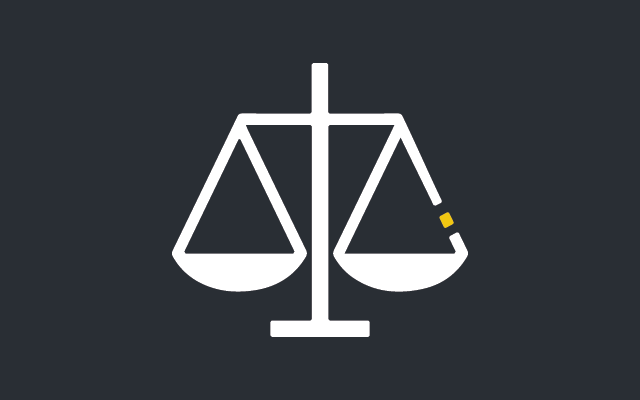The latest word from the Supreme Court on the Second Amendment
The United States has a problem with gun violence. Compared to other wealthy countries around the world, we aren’t even in the same ballpark. The U.S. is 19th when ranked for socioeconomic success, yet we are at the other end of the spectrum when it comes to deaths by gun violence. 28th from the bottom.
Here’s a chart that puts the U.S. next to the countries with the lowest rates of gun violence:

The chart comes from NPR with data from the Institute for Health Metrics and Evaluation which excludes deaths in armed conflict and from accidents or self-harm. For a longer discussion of world-wide gun death comparisons including more charts, check out the article.
Right to bear arms
Should lawmakers control gun ownership? Does the Constitution allow it?
The Second Amendment gives a right “of the people to keep and bear arms.” The exact text is written in 18th century lingo, so it’s hard to say how we’d word it today, but it contains some language that could qualify the right and make it applicable to only people serving in a state military.
Here is the exact language:
A well regulated Militia, being necessary to the security of a free State, the right of the people to keep and bear Arms, shall not be infringed.
One interpretation sees the right being granted unequivocally to “the people” — meaning all people. Reading the right-granting language alone, it seems clear the right applies to everyone.
The contrary reading, however, says the right is only related to having a “well regulated militia,” and the only reason the language says “the people” is because back then, the people were the state militia. State militia was important for protection against the federal militia, a concern of American Revolutionaries since they’d had to fight for independence from England.
A gun rights case must first resolve this ambiguity. Who does the “right to bear arms” apply to? Everyone or just members of the military?
If it’s just members of the military, then a state can restrict civilian gun ownership/use completely and the controversy is over. But if the right to keep and bear arms applies to everyone, then the next question is: When does the government have a good enough reason to restrict that right?
Reasonable restrictions
The government can always place reasonable restrictions on rights. For example, the First Amendment gives us the right to speak freely. But it’s really dangerous to yell FIRE in a crowded building; it may cause a stampede. The government has a good reason to ban that type of speech, especially since the value of the speech isn’t especially great.
Back to the Second Amendment: even if private civilians have the right to bear arms — e.g. to use them for hunting and self-protection — the government might still be able to control that right. But what types of restrictions are reasonable?
District of Columbia v. Heller
The Supreme Court last addressed gun control regulations in 2008 and 2010. The 2008 case — the more precedential of the rulings — was District of Columbia v. Heller.
The District of Columbia had passed two gun control laws. One law limited handgun ownership to one year licenses, and the other required all guns in the home be kept unloaded and disassembled or bound by a trigger lock.
Dick Heller, a D.C. special police officer, filed suit, arguing the laws infringed on his Second Amendment right to bear arms. Heller had a license to operate a handgun while on duty, but he wanted one for personal protection. He applied for a one-year license to have a handgun and was denied. Furthermore, Heller argued, that for any other guns he owns, he should be able to keep them in ready-position in the house. Heller said the Second Amendment does not allow the District to place those restrictions on his right to bear arms.
The Second Amendment analysis: who has the right to bear arms?
The Supreme Court decided D.C. v. Heller on a 5-4 ideological split. The conservative wing took the majority and ruled that both of the D.C. regulations violate the Second Amendment.
Regarding the textual ambiguity in the Second Amendment, the Court majority settled it: The Second Amendment right to bear arms applies to everyone. All Americans have the right to keep and use guns, not just for military defense, but for entertainment and for self-protection.
Scalia wrote the opinion. Scalia said the phrase “the people” is clear. When the phrase is used elsewhere in the Constitution and in the Bill of Rights, it means everyone in the national community, not just military members. Furthermore, Scalia said, “arms” in the Second Amendment includes weapons that aren’t just military weapons, but weapons that regular people would have or use. Even interpreting the word as it was used along with the verbs “keep” or “bear,” the interpretation is the same: “keeping arms” and “bearing arms” were used in reference to the actions of regular people, not of military members.
Scalia stepped away from the textual analysis to make an additional point. He said our rights were modeled from English philosophy, and a major authority on English law of the time (Blackstone) made clear that individual gun ownership rights were “fundamental” to “the natural right of resistance and self-preservation” and “the right of having and using arms for self-preservation and defence.”
What’s a reasonable regulation?
The Court admitted that the “the right secured by the Second Amendment is not unlimited” and the opinion mentioned types of gun control regulations that would be reasonable: “prohibitions on the possession of firearms by felons and the mentally ill, or laws forbidding the carrying of firearms in sensitive places such as schools and government buildings, or laws imposing conditions and qualifications on the commercial sale of arms.” The Court even said the carrying of “dangerous and unusual weapons” may be prohibited.
Then the Court evaluated the specific D.C. laws in the case. First was the law limiting handgun ownership. The DC law banned registration of handguns generally, but permitted limited handgun licenses for one year periods. The Court said the ban is a major infringement on the right to bear arms because the handgun is the preferred gun for self-defense. “[T]he inherent right of self-defense has been central to the Second Amendment right.” The handgun is “the quintessential self-defense weapon.” Without doing a balancing analysis that is often required in cases challenging limiting of civil rights, the Court concluded that the ban “amounts to a prohibition of an entire class of ‘arms’ that is overwhelmingly chosen by American society for that lawful purpose [of self defense]” and that law is unconstitutional.
As for D.C.’s requirement that guns in the home be kept in a nonfunctional state, the Court was similarly disapproving. The Court noted again the importance of guns for self-protection, and the house is a place in particular need of protection — one of the places the drafters of the Second Amendment had in mind — so the D.C. law could not stand.
Stevens’ dissent: only militia has the right to bear arms
Justice Stevens gave a dissenting interpretation of the Second Amendment. He said the “right to bear arms” applies only to members of the militia. His arguments included a contrary textual analysis and also a focus on the “contemporary concerns of the Framers.”
For his textual analysis, Stevens argued that the “militia” language should not be ignored because it obviously served a purpose, and in the case of the Second Amendment, it qualifies the entire “right to bear arms.” Stevens objected to the parallels the majority made about how the term “the people” is used elsewhere in the Constitution and similarly argued against the majority’s interpretation of “keep and bear arms” as pertaining to the general public. Stevens noted the term to “‘bear arms’ is a familiar idiom . . . meaning ‘to serve as a soldier, do military service, fight.’” (citing the Oxford Dictionary).
For Stevens’ argument about the intent behind the provision, he said that at the time the Second Amendment was written, there was a great fear of a standing militia. People sought protection against a national militia, and that protection would come through state militias. Thus, the Second Amendment stated a compromise in allocating military power in the new Nation, which is why the “right to bear arms” must be read in conjunction with use in the military.
Breyer’s dissent: the D.C. laws are reasonable regulations
Justice Breyer tackled the secondary question in the case. Assuming regular civilians have the right to bear arms, some regulations are reasonable. Thus, when considering the particular laws in this case, the D.C. regulations, the Court, Breyer said, must do a balancing analysis. How important is the government’s reason for the restriction, and how does that compare to the amount of liberty that is taken away?
Justice Breyer said the Court should have recognized a major important government interest in saving lives. Being such an important interest, evaluated the laws that D.C. created and looked at whether the District could have achieved its purpose in a less liberty-restricting way. He concluded the District’s laws were as tailored as possible to the important interest. From the dissenting opinion:
[A] legislature could reasonably conclude that the law will advance goals of great public importance, namely, saving lives, preventing injury, and reducing crime. The law is tailored to the urban crime problem in that it is local in scope and thus affects only a geographic area both limited in size and entirely urban; the law concerns handguns, which are specially linked to urban gun deaths and injuries, and which are the overwhelmingly favorite weapon of armed criminals; and at the same time, the law imposes a burden upon gun owners that seems proportionately no greater than restrictions in existence at the time the Second Amendment was adopted. In these circumstances, the District’s law falls within the zone that the Second Amendment leaves open to regulation by legislatures.
Recent Reports:
Featured
Delaware limits positions on several high courts to the two major political parties. Do the limits violate an Independent’s First Amendment rights to free association?
Aug 25, 2020


Absentee Voting: Supreme Court Acts on Emergency Applications from Alabama and Rhode Island
The Supreme Court responded to emergency applications regarding absentee voting measures in Alabama and in Rhode Island.
Aug 18, 2020

U.S. Patent and Trademark Office v. Booking.Com (Decision June 30, 2020)
Is the mark BOOKING.COM protectable as a trademark for online hotel reservation services?
Jul 2, 2020






Freedom of Speech and Expression
Aug 25, 2020